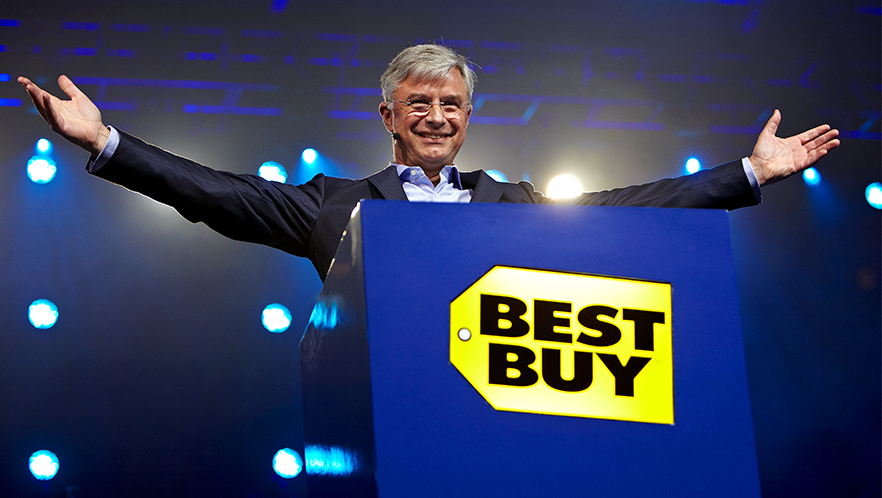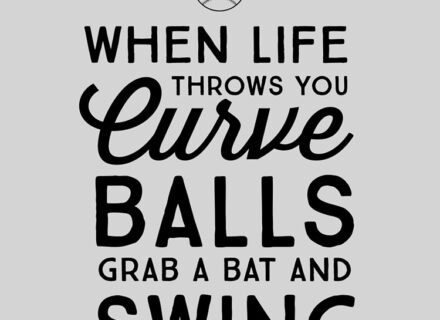Let’s start this conversation by taking a quick look at Best Buy’s stock performance over the last eight years, beginning toward the end of 2012, early 2013. That’s where a remarkable climb began with a new CEO at the helm.
Ignore Feb/March drop because, well, you know….. Coronavirus.
Enter Hubert Joly. His friends and peers thought he was crazy for taking the top job at a time when traditional, or sometimes called legacy businesses were getting their lunch eaten by the fast growth of online retail. Cough.. cough…… Amazon. Getting their lunch eaten puts it softly when the reality is that amazon was crushing many well-known retail brands. Think Borders and others that were simply too slow, or naive to act on the coming tidal wave Amazon would ultimately bring to their doorsteps.
Best Buy is clearly a different story, and one that I think a whole lot of businesses can learn from. I’ll unpack some of my takeaways in this post. I’ll do it chronologically and provide direct insights and quotes from Best Buy’s annual reports and shareholder letters, along with some notes from interviews I’ve watched or listened to with Mr. Joly.
2012/2013
After parting ways with former CEO, Brian Dunn, interim CEO Mike Mikan had been appointed to lead the company while the board conducted an exhaustive search to find a business leader that could dig the company out of the hole it was in, and attempt to thrive in the ‘Amazon-era’. Low prices, one-click purchasing, Prime, 1-day shipping, and other modern shopping and buying capabilities the online retail giant was rolling out at a mind-bending pace
Best Buy had found itself, unwittingly, transitioned from retailer to somewhat of a ‘showroom’ for Amazon. Would-be buyers walking into a bricks-and-mortar Best Buy location to browse, touch, demo, and explore the inventory only to leave empty handed. Later purchasing their goods at a lower price from Amazon.
The stopwatch on Joly’s charter to turnaround Best Buy had started, and the ‘Renew Blue’ transformation was underway.
There were five pillars to the transformation:
- Reinvigorate and rejuvenate the customer experience.
- Attract, grow, engage and inspire transformational leaders and employees.
- Work with vendors and partners to innovate and drive value.
- Increase our return on invested capital.
- Continue our leadership role in positively impacting the world.
2014
The FY2014 letter to shareholders began with confirmation that Best Buy had completed their first full year of the Renew Blue transformation. Joly provided details on their progress inside of each pillar. I’ll summarize key points.
- Reinvigorate and rejuvenate the customer experience.
- Increased Net Promoter Score by 300 basis points, signaling progress on improving the customer experience.
- Implemented a ‘low price guarantee’ to improve price competitiveness and embrace (i.e. defend against) “showrooming”.
- Implemented traffic-generating incentives that drove a 20% increase in domestic online sales.
- Rolled out ‘Ship-from-Store’ capability to 1,400 locations.
- Re-launched loyalty program.
- Attract, grow, engage and inspire transformational leaders and employees.
- Progress made improving the strength of the management team and improving employee engagement.
- Work with vendors and partners to innovate and drive value.
- Partnered with Samsung and Microsoft Windows to launch ‘stores-within-a-store’ in a win-win arrangement to showcase and sell new innovative products and services together.
- Increase our return on invested capital.
- Domestic same store sales were down 0.4%, but with some noise with rationalization of non-core businesses and short term disruption from optimizing retail floor space, store sales were essentially flat.
- Multi-year cost reduction targets exceeded, at $765M on a target of $725M, with $350M realized in FY ‘14.
- Operating margins not yet stabilized, but would come soon with cost savings and operational efficiencies still underway.
- Significantly strengthened balance sheet through renewed focus on core business and a substantially more disciplined approach to capital allocation.
- Continue our leadership role in positively impacting the world.
- The previous four pillars were moving Best Buy into a position of strength so they could deliver on this fifth pillar of positively impacting the world.
Looking ahead to their next chapter, which Joly called ‘Ignite the Possible’, In this phase they were focused on two problems they had to solve and their core strategy: To be the authority and destination for technology products and services. This was underpinned with their mission of ‘enriching people’s lives through technology’.
Significant progress has been made and the company was being rewarded with a growing share price. One thing that really stands out in Joly’s narrative all along the way is the emphasis on employee engagement. He believed deeply, and I agree wholeheartedly with this, that you cannot get customers engaged if you’re employees are not engaged first. He put strong leadership in place and relied on those leaders to engage the broader workforce. That was a foundational element of the strategy.
2015
Continuing the theme of engagement, you can see a trend in the personalization of the letters to shareholders. Not only did Joly do a masterful job getting employees and customers engaged, but he was running the same play with shareholders. He was creating belief that the strategy would continue unfolding as planned.
Now, two full years into the Renew Blue transformation, Best Buy articulated their value proposition around advice, service, and convenience at competitive prices. They began using Expert Service. Unbeatable Price as their signature.
Sales were up and operating income had improved 100 basis points YoY.
Joly and the Best Buy team continued realizing improvements across their strategic pillars.
- NPS was up another 450 basis points and they were gaining market share across multiple product categories.
- They continued to take price off the table as a decision factor for their customers through price match guarantees and other competitive tactics.
- They made significant improvements in online and offline customer experiences such as improved search capabilities online, faster shipping, and the chain wide rollout of their ship-from-store program.
Further changes drove improvements in stores with greater role clarity for their staff. They worked diligently to remove obstacles in decision making, moving decisions as close to the customer as possible. They also continued to bring in key talent to drive certain functions like E-Commerce, digital marketing, and supply chain management.
Within the vendor ecosystem, Joly and team continued to engage key vendor relationships to enable their in-store platform, giving customers the ability to touch and experience new innovations they may not otherwise be aware of. Best Buy’s unique assets and focus on customer experience would continue to prove attractive to customers as well as shareholders.
Financial performance would continue to move up and to the right as a result of the hard work the company was putting in. I want to emphasize that point. Turning any company around is incredibly hard work. It’s a whole lot more than words in a letter from the CEO in the form of strategic bullet points.
If we rewind back to when Joly first joined Best Buy in late 2012, he did something very important. Something it doesn’t take a lot of effort to do but that can yield tremendous results, and certainly did for Best Buy. He got out to their stores, observed, listened, asked questions, and learned some more. He took it all in so he could make the best decisions possible to get the company back on the right track.
In an interview at the Milken Institute, Joly said something I found quite interesting. He said, “He didn’t actually start with a grand strategy. He looked for the things that were already working and improving those things, the areas of momentum in the business. Running a business is like riding a bike, it’s really hard to steer if it’s standing still”.
“Running a business is like riding a bike, it’s really hard to steer if it’s standing still”.
Hubert Joly
To conclude the FY ‘15 letter to shareholders, Joly reminded everyone of the two year roadmap set at the beginning of 2015.
He said, “Our road map is structured around several key priorities:
- Merchandising: We will continue to create a compelling assortment online and in stores that provide a superior end-to-end customer experience and yields enhanced financial returns. In support of this, we are planning to continue rolling out more vendor experiences, as well as additional Pacific Kitchen and Home, and Magnolia Design Center stores-within-a-store.
- Marketing: We are continuing the evolution from analog and mass, to digital and personalized marketing. This includes the ongoing development of our Athena customer database to create even more targeted and relevant communication with our customers. As another example, we will ramp up our home-mover and wedding registry programs as a way of better assisting consumers during key events in their life.
- Online: Our goal is to serve customers based on how, when and where they want to be served. We will continue to enhance the omni-channel customer experience, whether a consumer is seeking to buy products or services on BestBuy.com, through our Best Buy app or in our stores.
- Retail Stores: We will continue driving increased sales effectiveness through a focus on individual sales productivity, and enhance the customer experience with expert service and a compelling, physical environment.
- Services: Our plan is to continue transforming our traditional service offerings to better address customer needs, while increasing our investments in the marketing of our Services offerings and better integrating Geek Squad into BestBuy.com.
- Supply Chain: We remain intent on leveraging our network and improving the customer experience with increased inventory availability, faster speed-to-customer and improved home delivery and installation.
- Cost Structure: We have launched phase two of our Renew Blue cost reduction and gross profit optimization program, with a target of approximately $400 million in annualized savings over three years.”
2016
By now it seems evident that the turnaround had caught steam and results were showing up on many dimensions.
- $1.5 billion of cash returned to shareholders.
- NPS increased another 300 basis points.
- Grew online domestic revenue by over 13% to more than $4 billion.
- $150 million in cost savings against the $400 million cost reduction and gross profit optimization goal. This was in addition to the $1 billion cost reduction over the previous few years.
- Significant increases in Non-GAAP return on invested capital (ROIC) from 9.2% in FY12 to 13.6% in FY16.
If we reflect back on the fifth pillar of the Renew Blue strategy, Best Buy was also making strides in positively impacting the world. Their recycling efforts had collected over 1 billion pounds of waste and they had reduced their carbon footprint by 20%, just as they set out to do.
While the top and bottom line results were showing up as Joly promised, a deeper dive into specific segments still needed work. The well-known Geek Squad segment was one such area. In the letter Joly remarked: “A critical component of our growth efforts is our services capabilities, including the Geek Squad. While it may not yet be visible in our quarterly financial results, we are making progress in this area. To do so, we had to spend time over the last two years fixing many aspects of our traditional warranty and repair businesses, including our pricing. We are seeing the results of our efforts through substantially higher Net Promoter Scores, an increased number of total customer interactions and improved attach rates.”
2016 was Best Buy’s 50 year anniversary, so it was a special milestone in many regards. Joly was now four years into his appointment as CEO. The next few years would continue to prove to be an impressive run.
2017
The third year in a row that Best Buy grew its Domestic comparable sales and non-GAAP operating income.
- Increased non-GAAP operating income rate from 4% in fiscal 2016 to 4.5%.
- Grew non-GAAP earnings per share by 28% from $2.78 in fiscal 2016 to $3.56.
- Returned $1.2 billion to our shareholders through dividends and share repurchases.
Continued execution against their priorities drove positive results in a number of areas. Joly highlighted the following:
- “We continued to gain share in home theater, appliances, computing and nearly all of the major product categories. We believe the total market for our product categories was down low-single digits in calendar 2016, so clearly our market share gains helped us offset the market decline.
- We increased our Net Promoter Score by more than 350 basis points.
- We grew Domestic comparable online revenue 21%.
- The successful Canadian transformation was the primary driver of more than $100 million in International operating income growth over last year.
- We have now achieved $350 million of our three-year target to reduce costs and optimize gross profit by $400 million, enabling us to invest in customer experience improvements while maintaining near-flat SG&A.
- Fiscal 2017 was a year of exploration and experimentation. We have been testing several concepts around the country that have the potential to be compelling customer experiences. We began to roll out a number of these experiences this year.”
2017 was also the year Best Buy concluded its ‘Renew Blue’ transformation, concluding that this phase of their work was officially complete.
The four year picture looks like this:
Following that conclusion, Best Buy launched what it refered to as ‘Best Buy 2020: Building the New Blue.
This was Best Buy’s move from focusing on a turnaround and early-stage growth initiatives to shaping their future as a company that keeps the customer at the core of everything they do and delivering superior returns to shareholders.
Joly outlined their Purpose, Roles, and Value Proposition.
As they looked out three years, to 2020, this also reshaped their pillars, moving from defense to offense.
Joly made a point to note that while their strategy was evolving, it was critical to maintain the disciplines they’d developed over the last four years in customer experience, cost management and savings, vendor partnerships and co-innovation, as well as on and offline experiences.
2018
This year’s performance was particularly strong. Total revenue climbed 7.0 percent to $42.2 billion, comparable sales rose 5.6 percent, and our non-GAAP operating income rate increased by 20 basis points.
Non-GAAP diluted earnings per share were $4.42, up 25.9 percent from $3.51 in fiscal 2017. And our non-GAAP ROIC increased to 22.2 percent, up from 18.7 percent in fiscal 2017.
In fiscal 2018, they returned a total of $2.4 billion to shareholders through dividends and share repurchases, up from $1.3 billion in fiscal 2017. In aggregate, for the past several years, they had been generating a total shareholder return well above the S&P 500.
By and large, 2018 was more of the same in terms of continued improvements in key metrics in the business.
You can begin to see the shift of moving from defense to offense, and a greater focus on corporate social responsibility and sustainability.
Joly outlined how they were doing just that:
“We believe businesses exist not only to deliver value to shareholders, but also to positively impact our various stakeholders, including society, and contribute to the common good. This holistic focus is a key responsibility our management and Board take seriously. Here are a number of ways we reflect this approach:
Company Strategy. We have anchored our strategy around a clear purpose of enriching customers’ lives through technology. We also have a clear set of values, as reflected in our Code of Business Ethics. We think that having our employees focused on our purpose and a clear set of values is a key driver of both performance and sustainability.
Employees. We are proud of the environment in which our employees operate, and of the strong levels of employee engagement and satisfaction we are achieving. We invest in the long-term development, effectiveness and engagement of our employees by working to ensure that we have a diverse workforce and inclusive environment, robust training and development programs, and a culture where our people can thrive. We received a perfect score of 100 in the Human Rights Campaign Foundation’s Corporate Equality Index and are ranked tenth in the world for employee training and development by Training Magazine.
Vendors. We partner with our vendors to help commercialize their innovations and bring them to life for the consumer. The company accomplishes this through customer-focused curation of the technology it sells online and in stores; effective, targeted marketing that reaches millions of relevant consumers; in-store demonstrations offering hands-on experiences for customers; needs-based selling expertise designed to solve problems and address lifestyle needs; and services that support customers in installing, setting up and operating their technology.
Supply Chain. We partner with our exclusive brand suppliers to ensure they meet our expectations for safe workplaces where workers are treated fairly. We perform audits, led by either us directly or third parties, to identify any gaps in factory performance and the industry standard code of conduct established by the Responsible Business Alliance. We also provide supplier training and assist in program development to support best practices in relation to conflict minerals, customs and trade anti-terrorism measures, and factory labor conditions.
Environment. We are committed to managing our impact on the environment and are proud of our efforts to lower our carbon footprint, reducing it by 60 percent by 2020. We operate the most comprehensive e-waste recycling service in the U.S. and have collected more than 1.5 billion pounds of e-waste for recycling since 2009. We are also committed to providing an assortment of sustainable technology, including ENERGY STAR® certified products, and have helped customers realize $707 million in utility savings since 2009.
Community. We are particularly excited about the commitment we have made to help prepare 1 million underserved teens for tech-reliant jobs each year by 2020. This will be accomplished through the operation of our Best Buy Teen Tech Centers (year round after school programs), which we plan to expand from 15 today to 60 by 2020; career mentoring and internship opportunities through our Career Pathways Program; hosted Geek Squad Academy events (free, interactive technology camps) across the country; more than 100,000 employee volunteer hours each year; and partnerships with other organizations.
2019 would be the year Joly’s era ends, passing the reins to a new CEO to lead Best Buy into the future.
2019
On April 15th, 2019, Joly and the board announced an evolution of leadership roles. Joly would transition the newly created role of executive chairman of the board, and Ms. Corie Barry, their, at the time, chief financial and strategic transformation officer, would become the fifth CEO in Best Buy’s 53-year history.
The 2019 letter to shareholders reflected on Joly’s run as CEO, highlighting the many accomplishments of their employees. The ‘blue shirts’, as they were referred to. All of the hard work that materialized in business results.
When addressing the talented people that enabled Best Buy to achieve the results it did, starting in 2012, Joly said:
- “Work can be an instrument for doing good things in the world.
- A company is a human organization – a group of individuals working together in pursuit of a goal, not a soul-less body.
- The purpose of a corporation is to contribute to the common good, by having a positive impact on its customers, employees, vendors, shareholders and the communities in which it operates. A business is more than for profit. It is about doing well by doing good.
- “Magic” happens if you can connect what drives the individuals working at the company to the purpose of the company. More broadly, we believe that great things happen at companies where the individuals who work there can feel a sense of purpose, develop personal connections, have autonomy, develop a certain mastery and feel they are in a growth environment.
- Work is not about attempting to achieve perfection, but about human connections. We believe performance and growth come from accepting and embracing our imperfections and vulnerabilities.
- Leadership is not about power, fame, glory or money. Leadership is about purposeful, authentic, human service.”
The letter ended with Joly thanking everyone involved, from employees, vendors, management, and others.
“On a personal level, I want to thank you, our shareholders, for your support over the past seven years. Likewise, I want to thank my colleagues for our collaboration and their friendship. Working together, we turned around and then grew this wonderful company, and it has been the honor of my professional lifetime to work with all of you. The company is in good hands with our new leadership, and I am confident that the journey we began in 2012 will continue well into the years ahead.”
Respectfully
One hell of a run, Mr. Joly. This is a case every business leader should understand and admire.
Source:
2012-2019 Annual Shareholder Letters
http://investors.bestbuy.com/investor-relations/financial-info/annual-reports-and-proxy-statements/default.aspx



